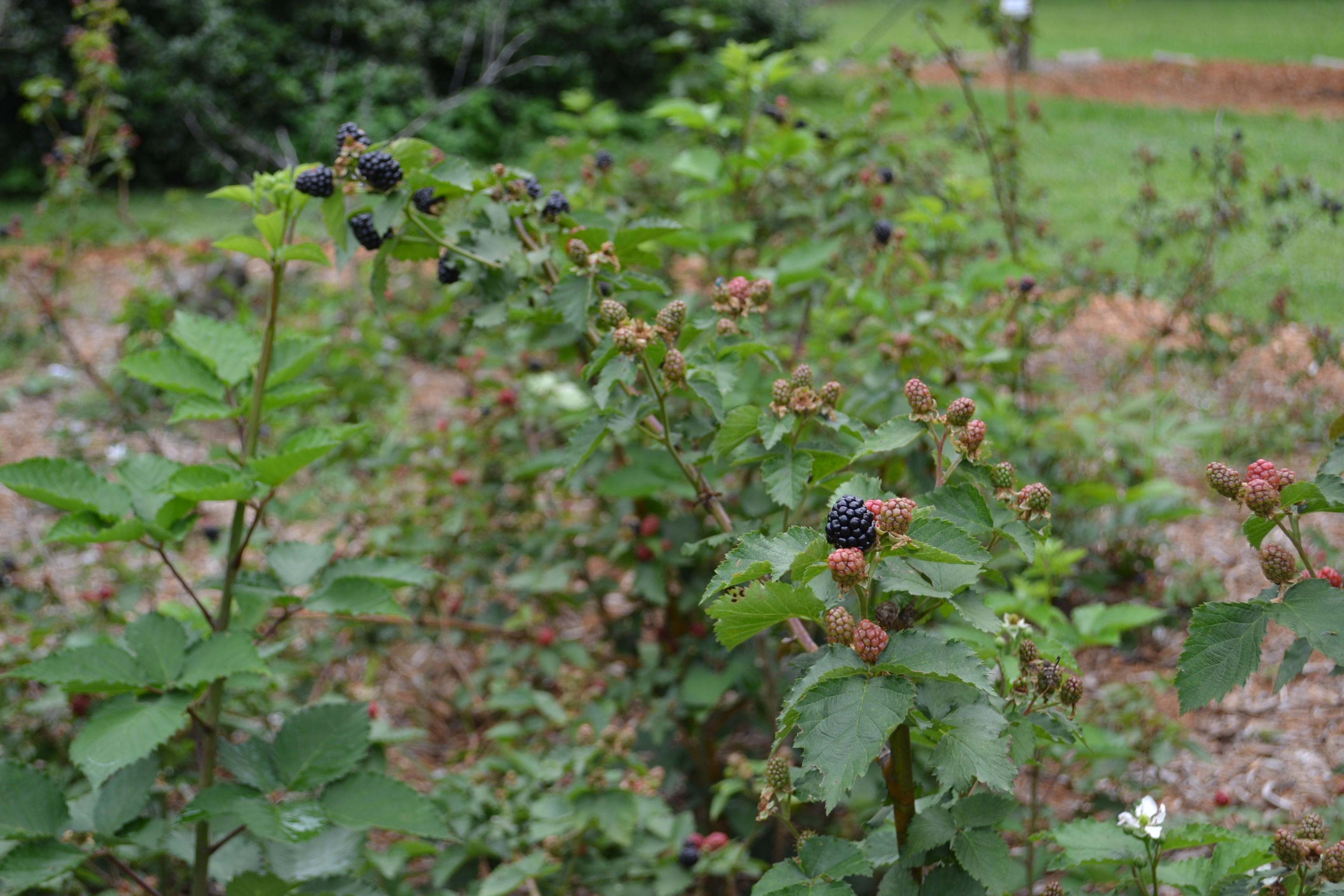
by Beth Bolles | Feb 14, 2017
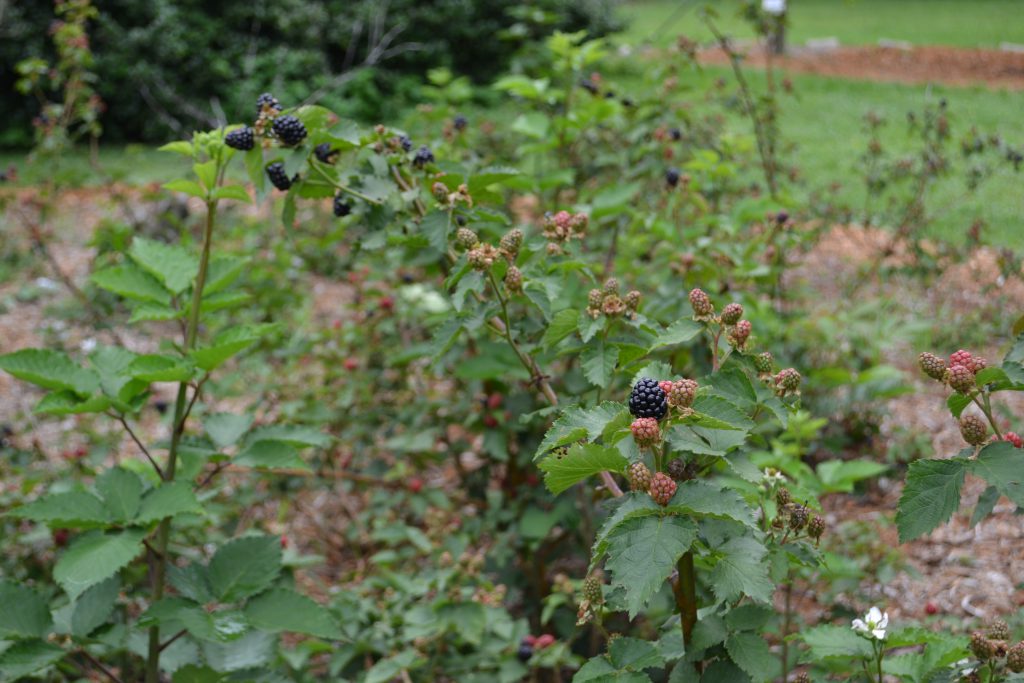
Arapaho blackberry has chill requirements that match those received in our area. Photo by Beth Bolles, UF IFAS Extension
Many of us are enjoying warmer temperatures this winter, but many deciduous fruit crops really need cold temperatures in order to break dormancy for the year. In areas that experience cold temperatures, plants have evolved the ability to survive by slowing growth and protecting sensitive tissues by going dormant. In order to break out of dormancy and begin growth again, plants experience an amount of chill hours (temps between 32 and 45 degrees F) that is suitable for specific areas. In our area, we normally range between 400 and 600 chills hours.
If we choose a fruit plant whose chill requirements match the amount of chill in our area, the plant will generally resume growth when it is safe for buds and tender tissues to develop. If we choose a plant with chill requirements higher than the amount our area receives, then the plant is not signaled to break dormancy and we end up with very sparse growth and no fruit.
So far in the winter of 2016-17, some areas have not received ‘normal’ amounts of chilling temperatures. Common fruit like apple, peach, some blueberries, and certain selections of blackberries may be affected by this by not breaking out of dormancy. This can impact your flower and fruit formation. For commercial growers, it can impact the amount of fruit available and even fruit prices at markets.
Since fruit trees are an investment of time and money, these are not plants that can be easily replanted to match chill hours with changing weather patterns. Perhaps planting fruit crops with a range of chill hours required might be beneficial Your future decisions to grow fruit trees may include crops that don’t rely as much on chill hours to be successful. For more information, please consult the Dooryard Fruit Varieties guide from UF / IFAS Extension.
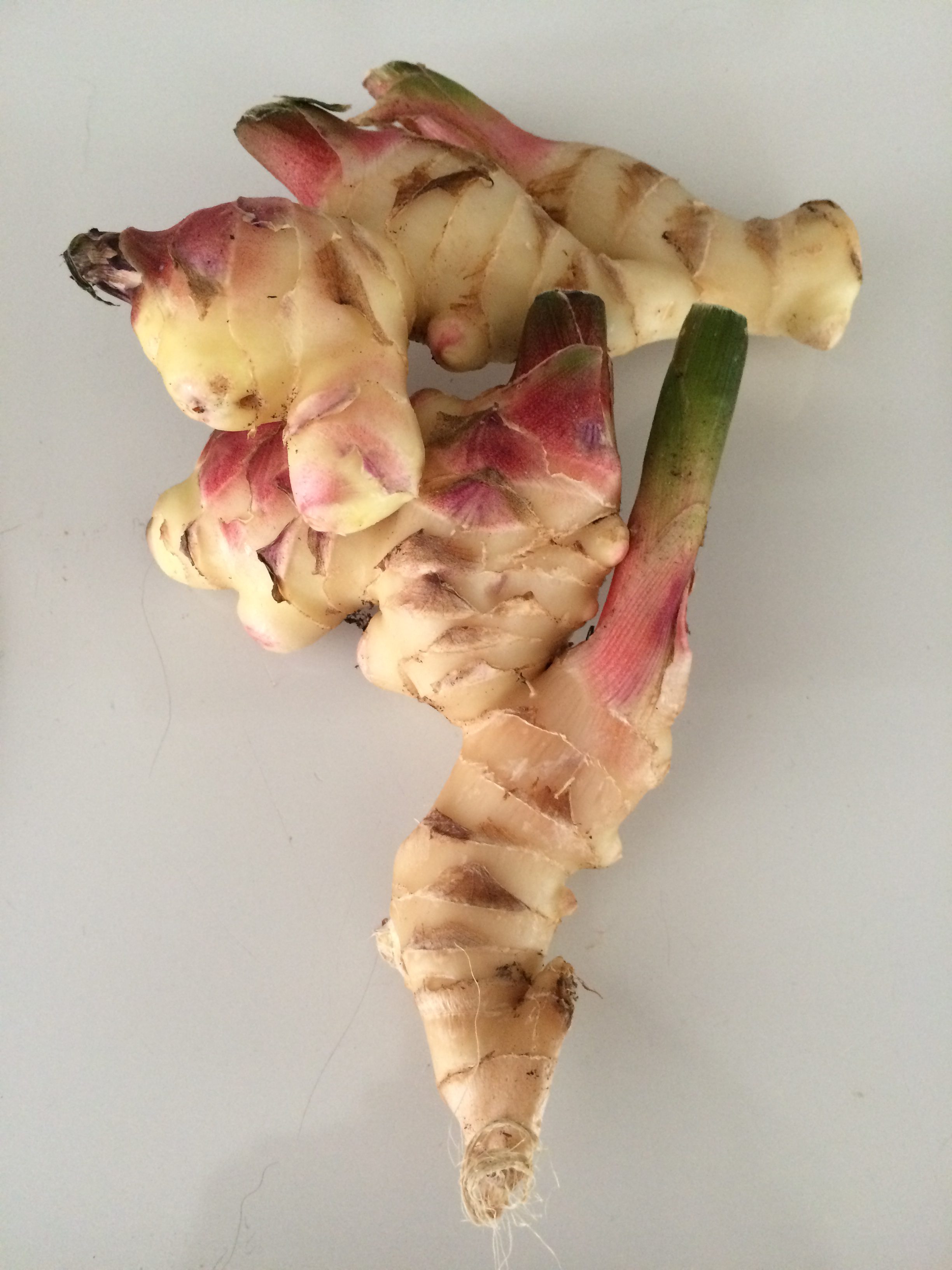
by Molly Jameson | Oct 26, 2016
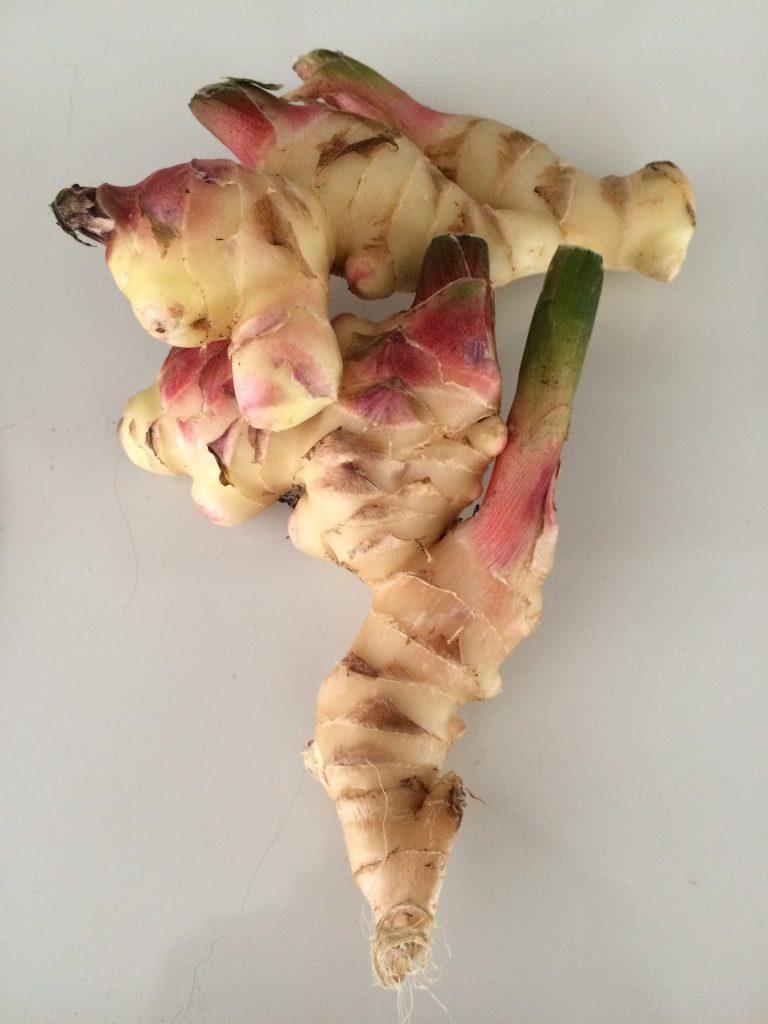
Freshly harvested ginger rhizomes. Photo by Molly Jameson.
Fall is finally here and we are beginning to enjoy our first few bursts of cold air coming in from the northwest. For many, this inspires us to prepare dishes with all of our favorite seasonal spices – nutmeg, cinnamon, cloves, and ginger come to mind. While all of these spices can be grown, did you know that edible ginger, Zingiber officinale, is one of the easiest roots to grow in North Florida?
It is as simple as planting a piece of fresh ginger root, or rhizome, in the spring and keeping the root moist for a few weeks while they sprout. Ginger prefers soil rich with organic matter and partial shade. Therefore, it is often an excellent choice for yards with many trees, as is common among our many oaks and pines. It also has very few pests and can be largely ignored as it grows throughout the year.
During the warm seasons, you will enjoy this perennial’s dark green narrow leaf blades, and although not as showy as ornamental gingers, it will occasionally produce green oblong stalks with white and dark red fragrant flowers. When our cool nights return and the tops die back, it is the signal to dig up the roots, which will have multiplied, and take some in for eating and place some back in the ground for next year’s harvest.
After digging up the rhizomes, allow them to air dry in the shade. To make your ginger root last, place in a sealed bag, and store in your freezer, peeled or unpeeled. You can then take out pieces as you need them throughout the year, and it can easily be grated frozen.
So get ready to make ginger bread, gingersnaps, ginger muffins, ginger ale, ginger-based sauces, ginger spiced soup, and so much more, all with your fresh, spicy, pungent homegrown ginger root!
by Les Harrison | Sep 28, 2016
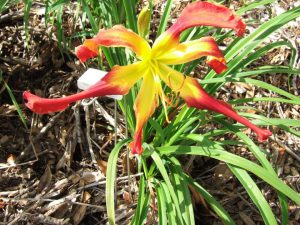
‘Wild Wookie’ Daylily. Photo credit: Sally Menk, Florida Master Gardener.
The daylily is a popular flowering perennial with East Asian origins which has adapted well to Florida landscapes. Plants are available in a wide variety of growth habits, flower shapes and colors, including yellow, orange, red, pink, purple, near-white and shades and combinations of all of these.
Flowering starts in March for early-season bloomers with late-season cultivars starting in mid-May. The typical bloom period is about four to seven weeks, although some varieties bloom even longer.
As their name accurately indicates, daylilies are members of the lily family, in the genus Hemerocallis. “Hemero” is Greek for “day” and “callis” for “beauty,” so the scientific name translates to beauty for a day.
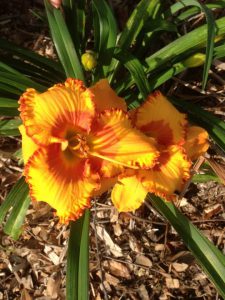
‘Cajun Dreaming’ Daylily. Photo credit: Sally Menk, Florida Master Gardener.
For the adventurous eater, the flower buds and petals of daylilies are edible raw, boiled, stir-fried, steamed, stuffed, or battered and fried. Dried daylily petals, called “golden needles,” are used in numerous Chinese dishes.
Many of the modern varieties of daylilies available today have been developed from native Chinese species. Early settlers from Europe and Asia brought many of the original species with them to America in earlier centuries.
Daylilies grow best in full sun or filtered shade. The darker colored red and purple varieties flourish better in partial shade, while light colored yellows, pinks and pastels varieties need full sun to bring out their best colors. The filtered light level under pine trees is ideal for growing daylilies. Heavy shade should be avoided because it will cause thin, spindly growth and poor flowering.
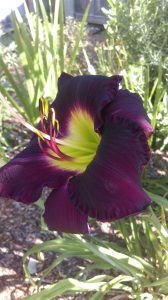
‘Bold Move’ Daylily. Photo credit: Jaci Zwierzchowski, Florida Master Gardener.
The soil of daylily beds should be topped with three to four inches of organic matter, such as peat, compost, or well-rotted manure. The amended soil should be mixed or tilled, leveled and then moistened. The soil pH should be between 6.2 and 6.8, with 6.5 being optimal.
Daylilies survive dry conditions well because of their extensive root systems. However, the number and size of blooms, plant growth, and overall vigor can be adversely affected by prolonged drought.
Daylilies multiply fairly rapidly and plant division is an easy way to propagate them for new locations in the home landscape or to share with friends. Division is best done immediately after the flowering season. Dig the entire clump and shake or wash off the soil without damaging the roots. It is easy to see where the divisions can be made with smaller clumps being easily pulled free to establish a new planting.
The home gardener can expand and share the beauty of these perennials, only spending a little time to accomplish this feat.
To learn more:
Daylilies for Florida

by Ray Bodrey | Aug 19, 2016
Being a gardener in the panhandle has its advantages. We’re able to grow a tremendous variety of vegetables on a year-round basis. However, in this climate, plant diseases, insects and weeds can often thrive. Usually, chemical measures are applied to thwart these pests. Some panhandle gardeners are now searching for techniques regarding a more natural form of gardening, known as organic. With fall garden planting just ahead, this may be an option for conventional vegetable gardeners looking for a challenge.
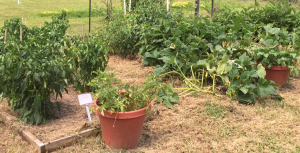
Vegetable Garden at UF/IFAS Extension Wakulla County. Photo credit: Ray Bodrey UF/IFAS.
So, what is organic gardening? Well, that really depends on who you ask. A broad definition is gardening without the use of synthesized fertilizers and industrial pesticides. Fair warning, “organic” does not translate into easier physical gardening methods. Laborious weeding and amending of soil are big parts of this gardening philosophy. This begs the question, why give up these proven industrial nutrient and pest control practices? Answer: organic gardening enthusiasts are extremely health conscious with the belief that vigorous outdoor activity coupled with food free of industrial chemicals will lead to better nutrition and health.
As stated earlier, the main difference between conventional and organic gardening is the methods used in fertilization and pest control. In either gardening style, be sure to select a garden plot with well-drained soil, as this is key for any vegetable crop. Soil preparation is the most important step in the process. To have a successful organic operation, the garden will require abundant quantities of organic material, usually in the form of animal manures and compost or mixed organic fertilizer. These materials will ensure water and nutrient holding capacity. Organic matter also supports microbiological activity in the soil. This contributes additional nutrients for plant uptake. Organic fertilizers and conditioners work very slowly. The vegetable garden soil will need to be mixed and prepped at least three weeks ahead of planting.
Effective organic pest management begins with observing the correct planting times, selection of the proper plant variety and water scheduling. Selecting vegetable varieties with pest resistant characteristics should be considered. Crop rotation is also a must. Members of the same crop family should not be planted repeatedly in the same organic garden soil. Over watering can be an issue. Avoid soils from becoming too wet and water only during daylight hours.
For weed management, using hand tools to physically removing weeds is the only control method. As for insect management, planting native plants in the immediate landscape of the organic garden will help draw in beneficial insects that will feast on garden insect pests. The use of horticultural oil or neem oil is useful. However, please read the product label. Some brands of oils are not necessarily “organic”. Nematodes, which are microscopic worms that attack plant roots, are less likely an issue in organic gardens. High levels of organic matter in soil causes an inhospitable environment for nematodes. Organic disease management unfortunately offers little to no controls. Sanitation, planting resistant varieties and crop rotation are the only defense mechanisms. Sanitation refers to avoiding the introduction of potential diseased transplants. Disinfecting gardens tools will also help. Hydrogen peroxide, chlorine and household bleach are disinfecting chemicals allowed in organic gardening settings as these chemicals are used in organic production systems for sanitation. Staking and mulching are also ways to keep plants from diseases by avoiding contact with each other and the soil.
Organic gardening can be a challenge to manage, but better health and nutrition could be the reward. Please take the article recommendations into consideration when deciding on whether to plant an organic garden. For more information, contact your local county extension office.
Supporting information for this article can be found in the UF/IFAS EDIS publication, Organic Vegetable Gardening in Florida, by Danielle D. Treadwell, Sydney Park Brown, James Stephens, and Susan Webb.
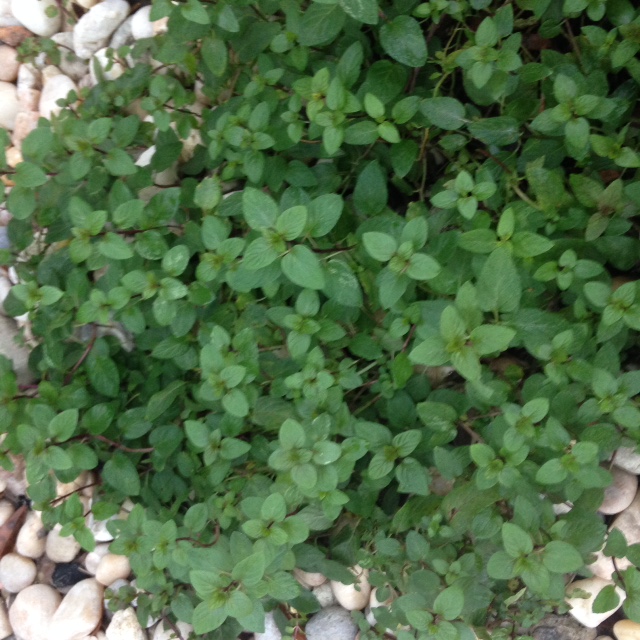
by Julie McConnell | Aug 12, 2016
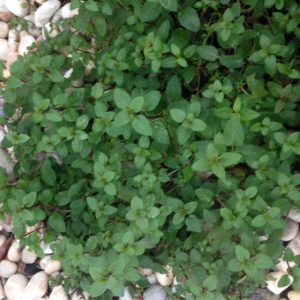
Chocolate mint has fragrant, dark green foliage and works well as a groundcover. Photo: Julie McConnell, UF/IFAS
Mint is very easy to grow in the right place, sometimes a little bit too easily. It’s reputation for being aggressive is well deserved. As with any other plant you use in your landscape, you need to be sure you have the right plant for the right place and there just might be such a spot in your garden for mint!
Garden areas with part sun/part shade and moist soil are perfect environments for mint. Like most herbs, it does not require much fertilizer and there are very few insects that bother it. Because mint forms runners where it touches the ground it is an ideal plant to use in areas that need soil stabilization as the dense growth habit will prevent erosion and sediment runoff.
Mint grows rapidly in the right conditions and can spread further than a gardener might want. However, it is not difficult to manage with a little maintenance. Because the plant is herbaceous rather than woody, it can be pulled or trimmed with little effort. Another method to keep it in bounds is to chemically edge using an herbicide on the portions that are growing beyond the bed border. Just keep in mind that if you plan to use your mint in food or drink you should only use chemical products labeled for edible crops and follow all label instructions closely.
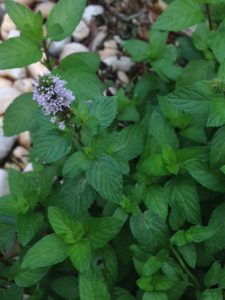
Mint flowers are attractive to pollinators. Photo: Julie McConnell, UF/IFAS
There are many different mints available such as chocolate mint, spearmint, and peppermint. Each has a slightly distinct flavor and may have different sized leaves or coloration. Mints are prolific bloomers and are attractive to pollinators such as bees and beneficial wasps.
To read more about mints please see http://gardeningsolutions.ifas.ufl.edu/plants/edibles/vegetables/mint.html
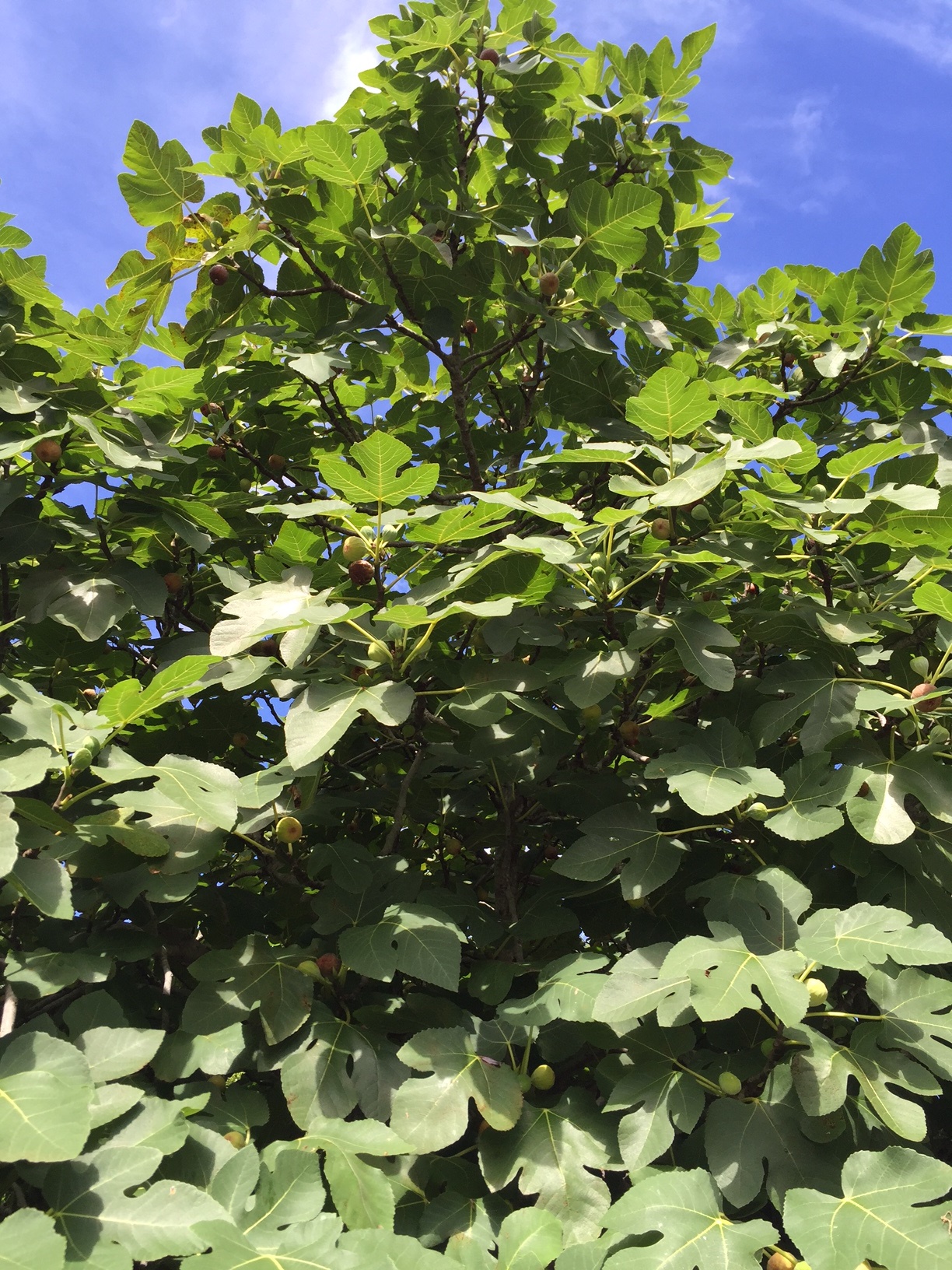
by Carrie Stevenson | Jul 26, 2016
Summer is full of simple pleasures—afternoon rainstorms, living in flip flops, and cooling off in a backyard pool. Among these, one of my favorites is walking out my door and picking handfuls of figs right from the tree. Before we planted our tree, my only prior experience with the fruit was a Fig Newton—I’d never eaten an actual fig, much less one picked fresh. Now, they are my favorite fruit.
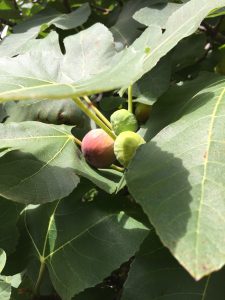
When ripe, figs are a deep shade of pink to purple. Larger green figs will ripen over the course of a few days. Photo credit: Carrie Stevenson
Native to Asia Minor and the Mediterranean, figs were introduced to Florida in the 1500’s by Spanish explorers. Spanish missionaries introduced these relatives of the mulberry to California a couple hundred years later. Figs are best suited to dry, Mediterranean-type climates, but do quite well in the southeast. Due to our humidity, southern-growing figs are typically fleshier and can split when heavy rains come through. The biggest threats to the health of the trees are insects, disease (also due to our more humid climate) and root-knot nematodes.
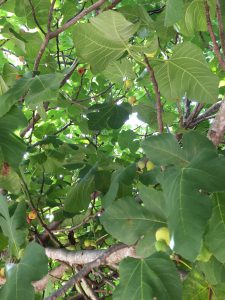
Fig trees can grow quite large and produce hundreds of fruit each year. Photo credit: Carrie Stevenson
Our tree started out just a couple of feet tall, but 12 years ago we replanted it along a fence in our back yard. It has grown so large (easily 25 feet tall and equally wide) that it hangs over our driveway, making it handy to grab a few as I hop in the car to run errands. The tree is in full sun at the bottom of a slope, and seems to be a satisfied recipient of all the runoff from our backyard. This position has resulted in a thick layer of soil and mulch in which it thrives.
We usually see small green fruit start to appear in early May, becoming fat and ripe by the second half of June. The tree produces steadily through early August, when the tree’s leaves turn crispy from the summer heat and there’s no more fruit to bear. The common fig doesn’t require a pollinator, so only one tree is necessary for production. The fiber-rich fig is also full of calcium, potassium, and vitamins A, E, and K. As it turns out, the “fruit” is actually a hollow peduncle (stem) that grows fleshy, forming a structure called a synconium. The synconium is full of unfertilized ovaries, making a fig a container that holds both tiny flowers and fruit in one.
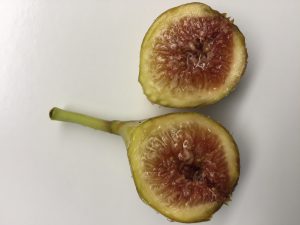
The insides of a fig show the small flowering structures that form the larger fruit. Photo credit: Carrie Stevenson
With the hundreds of figs we’ve picked, my family has made fig preserves, fig ice cream, baked figs and of course eaten them raw. We typically beg friends and neighbors to come help themselves—and bring a ladder—because we can’t keep up with the productivity. Often you can tell you’re near our tree from around the block, as the aroma of fermenting fruit baking on the driveway is far-reaching.
No matter what you do with them, I encourage planting these trees in your own yard to take full advantage of their sweet, healthy fruit and sprawling shade. As Bill Finch of the Mobile (AL) botanical gardens has written, “fresh…figs are fully enjoyed only by the family that grows them, and the very best figs are inevitably consumed by the person who picks them.”
















